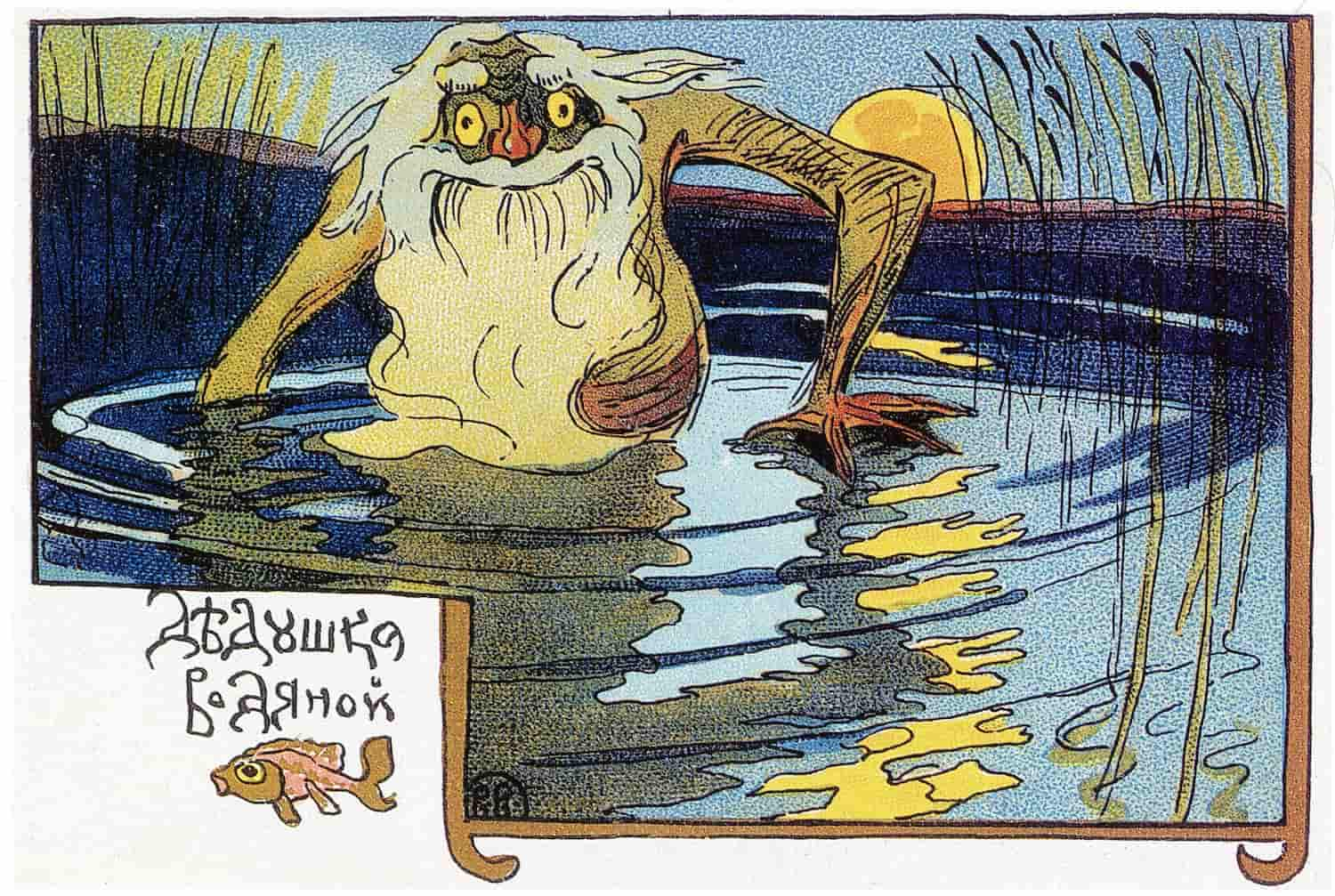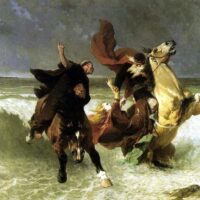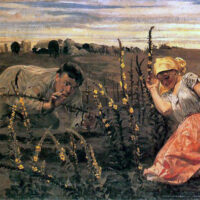The Vodyanoy or Vodník is a water demon from Slavic folklore that inhabits rivers, streams, lakes, and ponds. It bears resemblance to the German nixie or the Scottish kelpie. The Vodyanoy is known to both Western and Eastern Slavs, while among Southern Slavs, belief in it is limited to the Slovenes. Other South Slavs, however, knew beings called morski ljudi, creatures half-fish, half-human. Often, its companion is the water nymph or rusalka. The belief in the Vodyanoy stems from the Slavic water cult.
Etymology
The word for the water demon is simply derived from “water” in most Slavic languages, such as the Czech “vodník,” Russian “vodjanoj” (водяно́й), or Polish “wodnik.” In Czech, there is also an expression derived from the German “wasserman” meaning “water man.” Examples include names like “hastrman,” “vaserman,” “vastrman,” “bestrman” in Moravia, “hasrman” in Silesia, and “vosrmon” in Ještědsko.
Its usage dates back to the 14th century. The Lusatian Sorbian “nyks” and “nykus” are derived from the German “nixe,” meaning “water demon.” The term “šosáč,” used in the Litovel region, is derived from the widespread belief in its dripping “šos” (staff). The Polish “topielec” and “toplec” are derived from its typical activity, drowning.
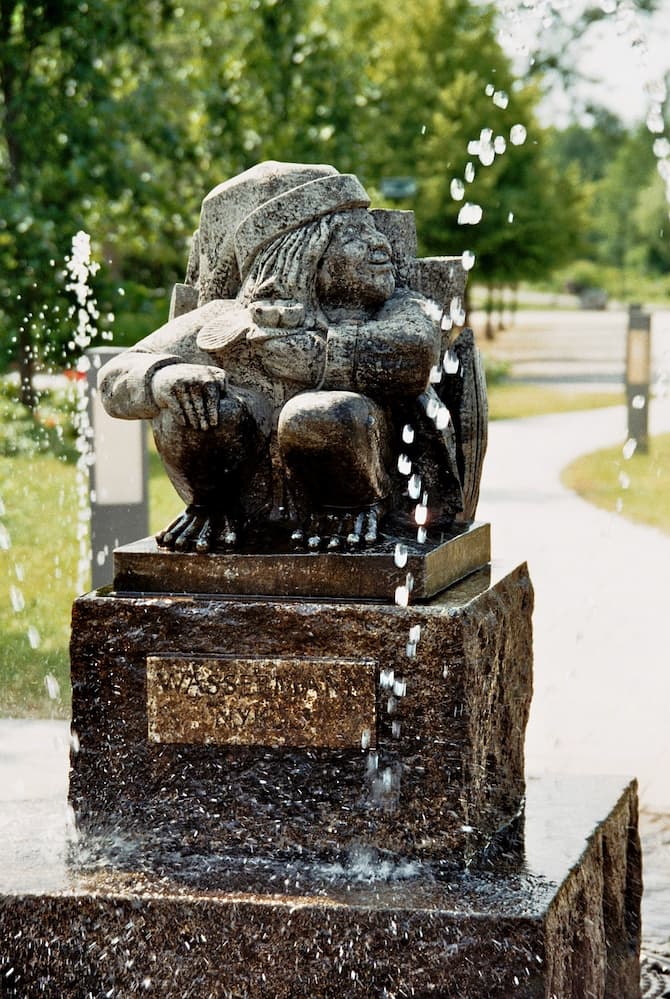
Characteristics
The depictions of the Vodyanoy are fundamentally similar among Slavs. It can take the form of a small man, an adult man, or an old man, often with green hair and beard. Among Western Slavs and Slovenes, it is well-dressed, usually in green or red, matching the color of its magical wand or broom used to control water. It can transform into a human, identifiable by the dripping water from its staff. It can also change into various animals, such as fish, horses, or frogs, and even inanimate objects.
It resides in the depths of waters, especially near mills, where it has its home or a crystal palace. The Vodyanoy is particularly active at night, clapping on the surface of the water, tossing itself like a fish, or combing its hair on the mill wheel. In water, it is powerful, while on land, it is generally weak. It rules over fish, water creatures, and water birds.
The Vodyanoy is either solitary or has a wife and daughters. Its bride is either a water nymph or a girl drowned or cursed by her father or mother, usually more benevolent toward humans than her husband. When its wife gives birth, it selects godparents from among humans, rewarding them with gold. Its daughters are often very beautiful and seduce human men.
The relationship with humans is generally negative, although in folklore and popular culture, it later became a more comedic character. Sometimes its behavior is mischievous, like scaring fishermen or tearing nets, while other times it is explicitly malevolent. It is especially dangerous to millers. Western Slavic Vodyanoys store the souls of drowned people in pots or pitchers.
A benevolent Vodyanoy helps fishermen by driving fish into their nets. There is a widespread belief that it frequents markets, and its presence predicts the abundance of crops or the prices of goods.
Folklore also includes sacrifices made to secure the Vodyanoy’s favor or protect against its wrath.
The origin of Vodyanoys was sometimes linked to the faljars, the drowned army of the Pharaoh from the biblical Exodus, or fallen angels cast into the water. According to another theory, they are deceased individuals, submerged in water from a cemetery where they were buried, and the holy water from baptism washed away.
Czech Republic
The Czech Vodník takes the form of a small man with green hair, well-dressed in green or red attire, from which water drips from its staff. According to another version, it is an ugly old green man with frog-like features such as a wide mouth, webbing between fingers, or bulging eyes. Sometimes it has a red right eye, water constantly dripping from its hair, and a body as soft as mud. It speaks in a hoarse and “twisted” manner.
It primarily lures children and young girls, for example, by hanging colorful ribbons and mirrors on the shore or transforming into a child that falls into the water and drowns its rescuer.
In later folklore and popular culture, the Vodyanoy lost its malevolence and became, like the devil, a comical character.
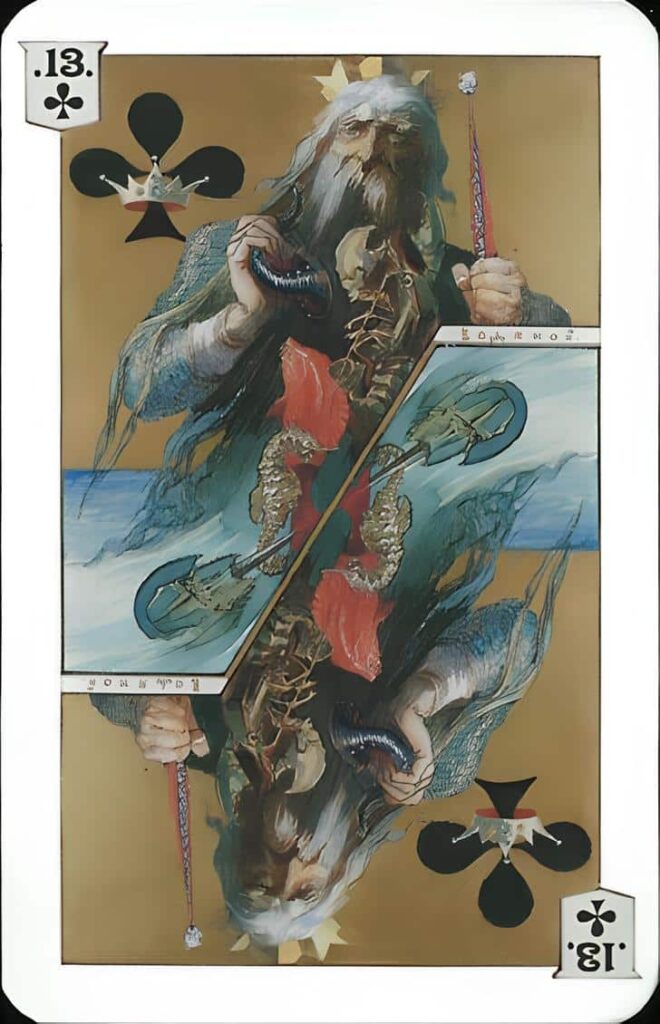
The Vodyanoy can be bound with linden bark ropes, colorful ribbons, blessed clappersticks on Palm Sunday, or a whip made of nine types of wood. A brave person can also neutralize it by cutting off its wet staff, wrapping it in a rosary, and burying it in consecrated soil or at a crossroads.
The Vodyanoy then pursues the person because if it doesn’t retrieve its staff by the next sunrise, it will perish. Plants like mugwort, wormwood, tansy, fern, or comfrey also serve as protection against it.
Poland
In Poland, a specific form of the Vodyanoy is the Bagiennik, supposedly inhabiting the surroundings of the Biebrza River. It resides in shallow marshes and ponds, reaching a size of about one meter. Its nostrils are located between its eyes or on its forehead, shooting a special mud that causes burns.
However, this substance also has healing properties. Encounters with it are usually not lethal.
Lusatia
The Lusatian Sorbian Wódny muž, Nyks, or Nykus have various forms. In Upper Lusatia, it is an adult man with a red coat and cap, while his wife has red stockings. In Lower Lusatia, it takes the form of a small child, also often dressed in red. Drowned people can also become Vodyanoys.
Russia
The Russian Vodyanoy is also called Vodjanoj, Vodovik, or Vodjanik, sometimes titled Děduška. It appears as a bald old man with a potbelly, swollen face, a high net cap, and belts made of water grass. Underwater, it tends herds of cattle, horses, sheep, and pigs. It includes fish in its herds, attracting them into the water where it resides. It rides a catfish but can also saddle a horse, bull, or cow, which it rides to death. In winter, it sleeps, and upon waking in spring, it breaks the ice.
Offerings to the Vodyanoy were common, such as a horse with its mane adorned with ribbons, a black pig, a goose, the first swarm of bees in moss, or butter poured into the water. In Russia, there was a belief that a living being, an animal, or even a person had to be buried in the foundations of a mill for the miller to prosper. In Ukraine, a horse’s head was buried in the dam to prevent the Vodyanoy from tearing it apart.
An explicitly negative form of the Vodyanoy is the Bolotjanyk, inhabiting swamps, and the Očeretjanyk, dwelling in marshes and reeds.
Slovenia
The Slovenian Povodnji mož, Vodeni mož, Gestrin, or Muk appears as a handsome young man or hunter, a man with long mustaches, or an old man. It wears a green skirt and a red hat. In another version, it is fish-like or green from the waist down, with green hair and beards and is very hairy. It lures its victims, especially young girls, whom it takes as a wife. It lets her go to her parents for a while, but in that case, it ties her on a long chain.
Serbia
In Serbia, the Vodyanoy is often depicted as a figure with claws and a long tail, covered in grass or moss, or as an old man with green hair and a beard, or as a fish covered in mud. During the day, it rests in a luxurious palace underwater, emerging in the evening to attack swimmers after sunset. It harbors hostility towards humans, especially men, whom it drags into the water to marry its daughters or make them its servants. It often damages watermills, fishing nets, and bridges. To appease it, millers and fishermen offer various sacrifices, such as a rooster, chicken, or sheep. Even a sacrificed horse with a stone around its neck was thrown into the water.
Vodyanoys live in water and never leave; however, this does not apply to female water spirits, rusalkas, who are referred to as such only once a year during Rusalka Week when they emerge into this world, leading to occasional confusion with nymphs. Both Vodyanoys and Rusalkas are described as having loose, long hair, often green or reddish due to the vegetation covering them.
Near watermills and bridges, where people frequently pass, Vodyanoys lurk, enticing and luring individuals to drown them. The Vodyanoy army, consisting of precisely one hundred beings, with the leader being the hundredth or the first, is considered most dangerous during storms, likely because it is harder to notice their approach through the water at that time. They renew their ranks by drowning people, stabbing them with tridents, tangling their legs with tails, whips, or reins, and dragging them to the depths to serve the Water Spirit, the master of water. While an ordinary Vodník can be resisted, in the presence of the old one, there is no salvation for the victims.
Vodyanoys are deemed malevolent beings because they drown people. In southern Serbia, even unruly children are warned, “The Vodyanoy took you away!” However, they do not act out of malice. The Water Spirit, their master, drowns people to transform them into its servants; it cares for its subjects, who live together with it in its crystal palace deep underwater. Some even marry their daughters, the Rusalkas.
In another version, it is a cruel master, as Vodyanoys emerge only from the wicked and sinful, who, as punishment, “live” in water. Traces of belief in Vodyanoys can be observed in many world cultures. The superstition that one should not mirror oneself in a river or any other large body of water is directly connected to these mythical beings; when a person mirrors, they are close to water, and Vodyanoys or the Water Spirit personally could pull them into the water and drown them.
Although universal mythological beings, Vodyanoys are best and most vividly represented in Slavic folklore, suggesting a potential truth to the theory that posits a much older history of Slavic peoples than currently recognized by modern history. Stone fisherman weights from Lepenski Vir in Serbia, dating back seven and a half to eight and a half thousand years, shaped like heads with their upper part painted in red, were used in Danube fishing. The appearance of these weights clearly indicates that, besides being anchor-like tools, they are also cult objects, perhaps replacing a sacrifice, indicating priesthood, or simply serving to “trick” Vodyanoys. In any case, they would have allowed prehistoric fishermen not to become their victims.
Sometimes, several of them gather under the wheel. The appearance of the Vodyanoy varies from place to place. In some regions, it has a human face but with disproportionately large ears and paws instead of hands, long horns, a tail, and eyes that glow like embers. In other areas, it resembles enormous human figures covered in grass and moss. It can also be entirely black, with glaring red eyes and a long nose.
There are those who envision it as an old man with green hair and a beard, with the beard turning white as the moon waxes. Vodyanoys are immortal but rejuvenate and age with lunar phases. Since it dislikes humans, the Vodyanoy preys on the unsuspecting, luring them into the water. Drowned victims become its slaves in the depths of its kingdom, represented by a crystal palace adorned with gold and silver. During the day, the Vodyanoy remains in its palace, emerging at night to stir the water and create a loud noise. Anyone in the water after sunset becomes its prey.
Hypotheses
Psychiatrist Vladimír Vondráček considered catfish, as well as frogs and otters, as the prototype of the Vodyanoy. The idea that it drowns men swimming on horses is explained by the fact that, during the lively belief in the Vodyanoy, swimming horses were the most common way to come into contact with water. The connection between the Vodyanoy and the horse is derived from Greek mythology, where the sea god Poseidon was also the god of horses.
Cultural Representation
The Vodyanoy is a common figure in folk legends, fairy tales, and works derived from them in popular culture.


